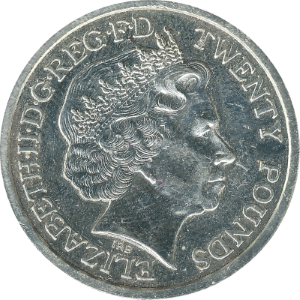- Pound Coin Uk
- Pound Coin Weight
- What Was The Old Pound Coins Expiry Date And What Can You Do ...
- 1983 One Pound Coin Value
The British one pound (£1) coin is a circulating denomination of the Pound Sterling. The coin was introduced in 1983 to replace the Bank of England one pound note which ceased to be issued at the end of 1984. The original coin was round and was made of nickel-brass. A large number of reverse designs were issued in this format until it was discontinued in 2016, and its legal tender status withdrawn at midnight on Sunday 15th October 2017.
The new 12-sided £1 coin was introduced into circulation in the United Kingdom on 28th March 2017, with coins minted earlier and dated 2016.
Pound Coin Uk

The coin has a 12-edged shape, similar to the pre-decimal brass threepence coin; it has roughly the same size as the previous £1 coin, and is bi-metallic like most £2 coins. Bimetallic means it is made of two metals - the outer ring is gold coloured (nickel-brass) and the inner ring is silver coloured (nickel-plated non-ferrous alloy).
Introducing the 1983 1 Pound Coin. After it was discovered that one pound notes, on average, only survived for about nine months in circulation, the Royal Mint issued this one pound coin in 1983 on 21 April, for the Queen’s birthday. A one pound coin can survive at least for 40 years.
- A £1 coin was called a Sovereign and was made of gold. A paper pound often was called a quid. More than a pound (£) 1 guinea and a £5.0.0 note. 1 guinea = £1-1s-0d ( £1/1/- ) = one pound and one shilling = 21 shillings or 21/- (which is £1.05 in todays money) 1 guinea could be written as '1g' or '1gn'.
- Rarest old pound coins According to coin collection specialists Change Checker, the 2011 Edinburgh £1 (pictured below) tops the list. The site ranks coins on a score from one to 100: the higher the rating, the more valuable the coin is likely to be. And the Edinbuirgh coin is the only one to score the full 100.
- Jul 30, 2020 Rarest old pound coins According to coin collection specialists Change Checker, the 2011 Edinburgh £1 (pictured below) tops the list. The site ranks coins on a score from one to 100: the higher the rating, the more valuable the coin is likely to be. And the Edinbuirgh coin is the only one to score the full 100.
Pound Coin Weight
A security feature is a 'latent image' - something like a hologram that changes from a '£' symbol to the number '1' when the coin is seen from different angles. Another security feature is micro-lettering - very small lettering on the lower inside rim on both sides of the coin, 'ONE POUND' on the obverse (“heads”) side and the year of production on the reverse side, for example '2016', '2017' etc.
What Was The Old Pound Coins Expiry Date And What Can You Do ...
The new design is intended to make counterfeiting (which affected the earlier type significantly) more difficult, and also has an undisclosed hidden security feature called 'iSIS' (Integrated Secure Identification Systems), thought to be a code embedded in the top layer of metal on the obverse of the coin, visible only under a specific wavelength of ultraviolet light.
1983 One Pound Coin Value
Coins issued in 2020 have now been circulating for only one year.